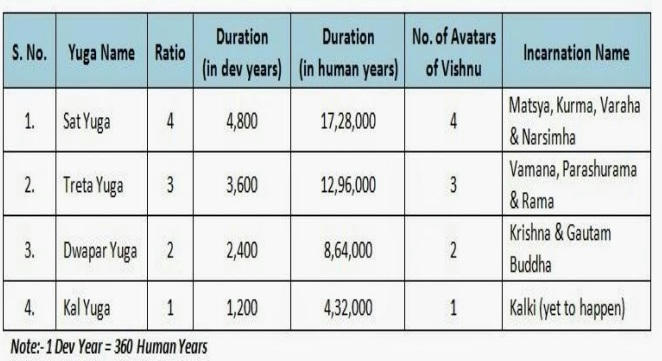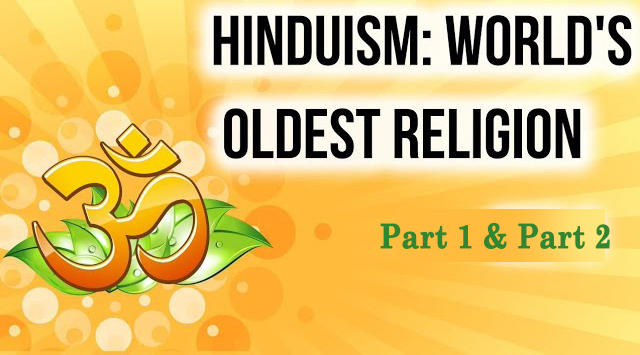Table of Contents
HINDUISM
PART 1
YUGA

HINDUISM
- Hinduism is the world’s oldest religion, according to many scholars, with roots and customs dating back more than 4,000 years. Today, with about 900 million followers, Hinduism is the third-largest religion behind Christianity and Islam.
- Hinduism contains a broad range of philosophies, , cosmology and pilgrimage to sacred sites. Hindu texts are classified into Śruti (“heard”) and Smṛti (“remembered”). These texts discuss theology, philosophy, mythology, Vedic yajna, Yoga, agamic rituals, and temple building. Major scriptures include the Vedas and Upanishads, the Bhagavad Gita.
ORIGINS
- The word Hindū is derived from Indo-Arya /Sanskrit root Sindhu. It is believed that Hindu was used as the name for the Indus River in the northwestern part of the Indian subcontinent.
- Hinduism includes a diversity of ideas on spirituality and traditions, but has no ecclesiastical order, no unquestionable religious authorities, no governing body, no prophet(s) nor any binding holy book; Hindus can choose to be polytheistic, pantheistic, monotheistic, monistic, agnostic, atheistic or humanist.
- Because of the wide range of traditions and ideas covered by the term Hinduism, arriving at a comprehensive definition is difficult.
- It is not easy to define Hinduism, we can say that it is rooted in India, most Hindus revere a body of texts as sacred scripture known as the Veda, and most Hindus draw on a common system of values known as dharma.
ORIGINS
- Hinduism originated around the Indus Valley near the River Indus in modern day Pakistan. About 80% of the Indian population regard themselves as Hindu.
- Most Hindus believe in a Supreme God, whose qualities and forms are represented by the multitude of deities which emanate from him.
- Hindus believe that existence is a cycle of birth, death, and rebirth, governed by Karma.
- The main Hindu texts are the Vedas and their supplements. These scriptures do not mention the word ‘Hindu’ but many scriptures discuss dharm.
CONCEPTS
- BRAHMAN – Brahman is a Sanskrit word which refers to a transcendent power beyond the universe. As such, it is sometimes translated as ‘God’ although the two concepts are not identical. Brahman is the power which upholds and supports everything. Most Hindus agree that Brahman pervades everything although they do not worship Brahman. Some Hindus regard a particular deity or deities as manifestations of Brahman.
- ATMAN – Atman means ‘eternal self’. The atman refers to the real self beyond ego or false self. It is often referred to as ‘spirit’ or ‘soul’ and indicates our true self or essence which underlies our existence.
KARMA
- It is a Sanskrit word whose literal meaning is ‘action’. It refers to the law that every action has an equal reaction either immediately or at some point in the futureIn Hinduism karma operates not only in this lifetime but across lifetimes.
- In a future human rebirth or reap the rewards of action in a heavenly or hell realm in which the self is reborn for a period of time.This process of reincarnation is called samsara.
- At death the soul is carried by a subtle body into a new physical body.The goal of liberation (moksha) is to make us free from this cycle of action and reaction, and from rebirth.
DHARMA
- It means ‘duty’, ‘virtue’, ‘morality’, even ‘religion’ and it refers to the power which upholds the universe and society. Dharma is the power that maintains society, it makes the grass grow, the sun shine, and makes us moral people or rather gives humans the opportunity to act virtuously.
- But acting virtuously does not mean precisely the same for everyone; different people have different obligations and duties according to their age, gender, and social position. Each person therefore has their own dharma known as sva-dharma.
- The importance of sva-dharma is illustrated well by the Bhagavad Gita.
CONCEPTS
- GURU – The terms guru and acharya refer to a teacher or master of a tradition. The basic meaning is of a teacher who teaches through example and conveys knowledge and wisdom to his disciples.
- VARNA – An important idea that developed in classical Hinduism is that dharma refers especially to a person’s responsibility regarding class (varna) and stage of life (ashrama). This is called varnashrama-dharma.
CLASSES OF VARNA
- Brahmans or Brahmins – the intellectuals and the priestly class who perform religious rituals
- Kshatriya (nobles or warriors) – who traditionally had power
- Vaishyas (commoners or merchants) – ordinary people who produce, farm, trade and earn a living
- Shudras (workers) – who traditionally served the higher classes, including labourers, artists, musicians, and clerk
VARNA
- People in the top three classes are known as ‘twice born.The twice born traditionally could go through four stages of life or ashramas. The ashrama system is as follows:
- Brahmacarya – ‘celibate student’ stage in which males learned the Veda
- Grihastha – ‘householder’ in which the twice born male can experience the human purposes (purushartha) of responsibility.
- Vanaprastha – in which the twice born male retires from life in the world to take up pilgrimage along with his wife.
- Samnyasa – ‘renunciation’ in which the twice born gives up the world, takes on a saffron robe or, in some sects, goes naked, with a bowl and a staff to seek moksha (liberation) or develop devotion
CAMPAIGN AGAINST NIZAM

CLASSIFICATION
Classified by primary deity or deities, four major Hinduism modern currents are Vaishnavism (Vishnu), Shaivism (Shiva), Shaktism (Devi) and Smartism (five deities treated as same)
HINDUISM
PART 2
CLASSIFICATION
Classified by primary deity or deities, four major Hinduism modern currents are Vaishnavism (Vishnu), Shaivism (Shiva), Shaktism (Devi) and Smartism (five deities treated as same)
SCRIPTURES(VEDAS)
- These are the most ancient religious texts which define truth for Hindus.
- They got their present form between 1200-200 BCE and were introduced to India by the Aryans.
- Hindus believe that the texts were received by scholars direct from God and passed on to the next generations by word of mouth.
- Vedic texts are sometimes called shruti, which means hearing.
CONTENT OF THE VEDAS
- The Vedas are made up of four compositions, and each veda in turn has four parts which are arranged chronologically.
- The Samhitas are the most ancient part of the Vedas, consisting of hymns of praise to God.
- The Brahmanas are rituals and prayers to guide the priests in their duties.
- The Aranyakas concern worship and meditation.
- The Upanishads consist of the mystical and philosophical teachings of Hinduism.
SAMHITA
- Rig-Veda Samhita (c. 1200 BCE) is the oldest of the four vedas and consists of 1028 hymns praising the ancient gods.
- Yajur-Veda Samhita is used as a handbook by priests performing the vedic sacrifices.
- Sama-Veda Samhita consists of chants and tunes for singing at the sacrifices.
- Atharva-Veda Samhita (c. 900 BCE) preserves many traditions which pre-date the Aryan influence and consists of spells, charms and magical formulae.
UPANISHAD
- The Upanishads were so called because they were taught to those who sat down beside their teachers. (upa=near, ni=down, shad=sit).
- The major Upanishads were largely composed between 800-200 BCE and are partly prose, partly verse.
- Later Upanishads continued to be composed right down to the 16th century. Originally they were in oral form.
- Central to the Upanishads is the concept of brahman; the sacred power which informs reality.
SHRI BHAGWAT GEETA
- The Bhagavad Gita, or “Song of the Lord” is part of the sixth book of the Mahabharata, the world’s longest poem.
- Composed between 500 BCE and 100 CE, the Mahabharata is an account of the wars of the house of Bharata.
- The Bhagavad Gita takes the form of a dialogue between prince Arjuna and Krishna, his charioteer.
- Arjuna is a warrior, about to join his brothers in a war between two branches of a royal family which would involve killing many of his friends and relatives.He wants to withdraw from the battle but Krishna teaches him that he, Arjuna, must do his duty in accordance with his class and he argues that death does not destroy the soul.
RAMAYANA
- Composed in the same period, the Ramayana is one of India’s best known tales.
- It tells the story of Prince Rama who was sent into exile in the forest with his wife, Sita, and his brother, Lakshamana.
- Sita was abducted by the evil demon Ravana but ultimately rescued by Prince Rama with the help of the Monkey God, Hanuman.
- The story is written in 24,000 couplets.
- The symbolism of the story has been widely interpreted but basically is the story of good overcoming evil. Many people have said that it is a story about dharma or duty.
DEITIES
- BRAHMA – Brahma is the first god in the Hindu triumvirate, or trimurti. The triumvirate consists of three gods who are responsible for the creation, upkeep and destruction of the world. The other two gods are Vishnu and Shiva.
- Vishnu is the preserver of the universe, while Shiva’s role is to destroy it in order to re-create.
- Brahma’s job was creation of the world and all creatures. His name should not be confused with Brahman, who is the supreme God force present within all things.
- Brahma is the least worshipped god in Hinduism today. There are only two temples in the whole of India devoted to him, compared with the many thousands devoted to the other two.
BRAHMA

VISHNU
- Vishnu is the second god in the Hindu triumvirate (orTrimurti). The triumvirate consists of three gods who are responsible for the creation, upkeep and destruction of the world. The other two gods are Brahma and Shiva.
- So far, he has been incarnated nine times, but Hindus believe that he will be reincarnated one last time close to the end of this world.
- Two of Vishnu’s incarnations, Rama and Krishna, are also the subject of the epic stories Ramayana and Mahabharata, respectivel


SHIVA
- Brahma is the creator of the universe while Vishnu is the preserver of it. Shiva’s role is to destroy the universe in order to re-create it.
- Shiva is known to have untamed passion, which leads him to extremes in behaviour. Sometimes he is an ascetic, abstaining from all wordly pleasures.
- It is Shiva’s relationship with his wife, Parvati which brings him balance. Their union allows him to be an ascetic and a lover, but within the bounds of marriage.

DIETIES

LAKSHMI
- Lakshmi is the consort of the god Vishnu. She is one of the most popular goddesses of Hindu mythology and is known as the goddess of wealth and purity.
- Lakshmi is commonly portrayed as a beautiful woman with four arms, standing on a lotus flower. There is usually one, or sometimes two elephants behind her, anointing her with water. She is often depicted sitting beneath Vishnu, massaging his feet.
LAKSHMI

























 WhatsApp
WhatsApp